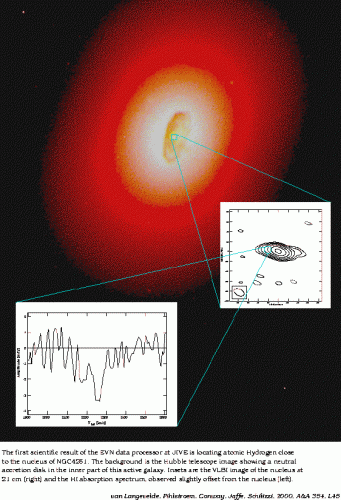New data processor reveals hydrogen gas around black hole
Dutch and Swedish astronomers have obtained the first scientific results using the new correlator at the Joint Institute for VLBI in Europe (JIVE) in Dwingeloo, the Netherlands. The team, led by Dr. Huib van Langevelde uncovered atomic hydrogen within 20 light-years of the black hole in the nucleus of the galaxy NGC 4261 at a distance of one hundred million light-years. The observations were made with radio telescopes in Germany, Italy, the Netherlands, Poland, Sweden and the United Kingdom. The recordings on tape were combined at the correlator and resulted in a resolution that is even better than that of the Hubble Space Telescope. Ylva Pihlström of the Onsala Space Observatory near Gothenburg carried out a large fraction of the astronomical analysis.
Simultaneous co-observations by the large radio telescopes in Europe in the Very Long Baseline Interferometry (VLBI) Network, makes the detection of gas so close to the nucleus possible. Over the last couple of years the radio telescope dishes have been equipped with new recorders to enhance their sensitivity. To combine the data a new central data processor facility was required. Last summer this correlator at JIVE became operational. The data processor is a super-computer which combines the recordings from the individual telescopes with extremely high accuracy and at a rate of 16 thousand billion operations per second.
The bright nucleus of the galaxy NGC4261 is surrounded by a disk of neutral material with a size of 800 light-years. Previous investigations of the rotation of the disk are consistent with the presence of an approximately 500 million times solar mass black hole in the center of the active galaxy. The Hubble telescope could distinguish this disk up to 46 milli-arcsec from the nucleus, which corresponds to 50 light-years from the black hole. Now it has been shown that atomic hydrogen is located as close as 15 milli-arcseconds from the nucleus.
The new observations were carried out at a radio-wavelength of 21cm (see figure). From the spectrum it appears that the hydrogen can be detected at a location where the disk covers the VLBI source. This proves that the inner twenty light-years of the disk consists of atomic material. There are clues that even closer in, the disk becomes ionized, while the material detected by the Hubble telescope is made out of molecular gas. Apparently the gaseous disk experiences increased heating closer to the central object. It is generally believed that such accretion disks are feeding the black hole, a process that is likely to be the origin of the extended jets in these active galaxies.

The scientific result described here appeared in the February issue of Astronomy and Astrophysics (354, L45-L48).
Preprints of the paper are available in PDF format.
Further information: Dr. Huib Jan van Langevelde tel: +31 (0)521 596515, e-mail: langevelde@jive.nl
